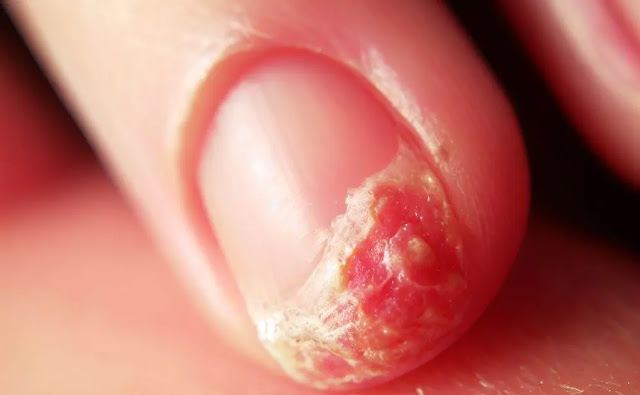Signs of skin cancer under nails - Skin cancer is a prevalent and potentially life-threatening condition that affects millions of people worldwide. While most individuals are aware of the risks of sun exposure and the importance of protecting their skin, they may overlook the possibility of skin cancer developing under their nails. Subungual melanoma, a rare type of skin cancer, specifically affects the area beneath the nails. Early detection of skin cancer under the nail is crucial for timely treatment and improved outcomes. In this article, we will explore the signs and symptoms of subungual melanoma and emphasize the importance of vigilance and regular self-examination.
Subungual melanoma is a subtype of skin cancer that originates in the nail matrix, where keratin forms. It is important to distinguish subungual melanoma from other nail-related cancers, such as ungual melanoma or periungual melanoma, as they have distinct characteristics and treatments. Subungual melanoma accounts for approximately 0.7% to 3.5% of all melanoma cases worldwide. While prolonged sun exposure is a significant risk factor for most types of skin cancer, subungual melanoma appears to be unrelated to sun exposure. Other risk factors for melanoma, such as having many moles or abnormal moles, fair skin, a family history of melanoma, or a weakened immune system, may increase the likelihood of developing subungual melanoma.
Common Symptoms of Subungual Melanoma
Recognizing the signs and symptoms of subungual melanoma is crucial for early detection and prompt medical intervention. Individuals should pay close attention to any changes occurring under their nails. The following are common symptoms associated with subungual melanoma:
- Brown or Black Streaks Under the Nail: One of the most prominent signs of subungual melanoma is the appearance of brown or black streaks under the nail. These streaks may resemble normal bruising or discoloration, but they persist and gradually increase in size.
- Nail Discoloration and Changes: Subungual melanoma can cause significant changes in the color and appearance of the nail. The affected nail may exhibit abnormal pigmentation, appearing darker than the surrounding nails. It is essential to note any significant alterations in the color or texture of the nail.
- Bruise That Does Not Heal: A bruise under the nail that fails to heal or move up as the nail grows is another potential sign of subungual melanoma. Unlike a typical bruise that resolves within a few weeks, a persistent bruise under the nail should be examined by a healthcare professional.
- Separation of the Nail from the Nail Bed: In some cases, subungual melanoma can cause the nail to separate from the nail bed. This separation, known as onycholysis, may be accompanied by pain or discomfort. Any unexplained nail detachment should be investigated further.
- Darkening of the Skin Next to the Nail: Subungual melanoma can lead to the darkening of the skin surrounding the nail. This darkened skin, known as periungual pigmentation, may extend beyond the nail and serve as an additional warning sign.
- Bleeding or Development of a Nodule on the Nail: In advanced stages of subungual melanoma, individuals may experience bleeding from the nail or the development of a nodule on the nail. These symptoms should not be ignored and require immediate medical attention.
- Thinning, Cracking, or Distortion of the Nail Plate: Subungual melanoma can cause changes in the structure and appearance of the nail plate. Individuals may notice thinning, cracking, or distortion of the nail. These changes should raise concerns and prompt further evaluation.
Hutchinson's Sign and Other Indicators
Hutchinson's sign is a crucial indicator of subungual melanoma. It refers to the extension of nail pigment onto the skin surrounding the nail. If nail pigment is present on the skin, it suggests the involvement of the nail matrix and the possibility of subungual melanoma. Additionally, it is important to note that subungual melanoma may occasionally occur without the typical pigmented streaks. In such cases, individuals may experience symptoms similar to subungual infections, including changes in the nail, bleeding, and pain at the nail bed. Any persistent or concerning symptoms should be evaluated by a healthcare professional to rule out subungual melanoma.
Diagnosis and Medical Evaluation
Diagnosing subungual melanoma requires a comprehensive medical evaluation. A healthcare professional, typically a dermatologist, will conduct a physical assessment of the affected nail and inquire about symptoms and medical history. To differentiate subungual melanoma from other nail conditions, such as onychomycosis or squamous cell carcinoma, a biopsy of the nail matrix and nail bed is necessary. A specialist in pathology will examine the collected tissue samples under a microscope to determine if they contain cancerous cells consistent with the appearance of melanoma. If subungual melanoma is confirmed, additional tests may be conducted to assess the extent of cancer and determine the appropriate stage.
Treatment Options for Subungual Melanoma
The treatment approach for subungual melanoma depends on various factors, including the stage and extent of the cancer. Surgical removal of the affected area, such as the entire nail or a portion of the digit, is the primary treatment method. This surgical intervention aims to eliminate the cancerous cells and prevent further spread. In cases where cancer has metastasized to the lymph nodes or other organs, additional therapies such as radiation and chemotherapy may be recommended to target and destroy cancer cells. The treatment of subungual melanoma often involves a multidisciplinary approach, with dermatologists, surgeons, oncologists, and other specialists collaborating to provide the best possible care. Also, read about Mohs surgery for skin cancer.
Subungual Melanoma vs. Subungual Hematoma
It is essential to distinguish between subungual melanoma and subungual hematoma, a non-cancerous condition resulting from nail trauma. While subungual melanoma presents persistent dark marks under the nail, subungual hematomas are caused by blood vessel rupture due to injury. Common sources of subungual hematoma include trapping a fingernail in a closing door or wearing tight shoes. Subungual hematomas can be painful and may lead to infection, accompanied by symptoms like fever and inflammation. However, subungual hematomas are not cancerous. If dark marks appear under the nail without a known injury or trauma, it is crucial to consult a healthcare professional for an accurate diagnosis and appropriate management.
Prognosis and Importance of Early Detection
The prognosis for subungual melanoma varies depending on the stage at the time of diagnosis. Early detection significantly improves the chances of successful treatment and favorable outcomes. According to the American Cancer Society, the 5-year survival rate for localized melanoma is 99%, indicating a high likelihood of survival when the cancer is limited to the site of origin. However, regional and distant metastatic melanomas have lower survival rates, with a 5-year survival rate of 66% for regional melanomas and 27% for distant metastatic melanomas. Regular self-examination and awareness of the signs and symptoms of subungual melanoma are crucial in achieving early detection and prompt medical intervention.
Skin cancer under the nail, known as subungual melanoma, is a rare but serious condition that requires attention and vigilance. Recognizing the signs and symptoms, understanding the risk factors, and seeking timely medical evaluation is essential for early detection and effective treatment. Regular self-examination of the nails, particularly for individuals with risk factors, can aid in identifying any concerning changes. If any suspicious symptoms, such as persistent pigmented streaks, nail discoloration, or nail detachment, arise, it is important to consult a healthcare professional for a thorough evaluation. By promoting awareness and proactive monitoring, we can work towards improving outcomes and reducing the impact of subungual melanoma on individuals' health and well-being.


